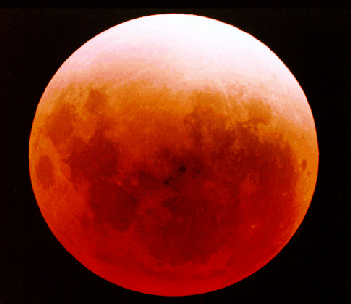Astronomy Picture of the Day
Discover the cosmos!
Each day a different image or photograph of our fascinating universe is
featured, along with a brief explanation written by a professional
astronomer.
April 3, 1996

A Lucky Lunar Eclipse
Credit and Copyright:
Andy Steere
Explanation:
Tonight's full moon would normally washout the spectacle of
Comet Hyakutake's lovely tail,
even for those far from light
polluted skies. Except that tonight comet observers are in luck - the
dance of the planets calls for a
total lunar eclipse!
Lunar eclipses are
caused when the Moon
passes through the Earth's shadow.
Although dimmed,
the eclipsed Moon may not appear completely dark.
Sunlight scattered into the
Earth's shadow after passing
around the planet's edge and
through its dusty atmosphere
can make the Moon take on dramatic shades of red during totality as
demonstrated in the above photo of the
November 1993 lunar eclipse.
Tonight,
totality begins at 6:26 p.m. EST and lasts
about an hour and a half. Weather permitting, the eclipse will be visible
for all those comet and moon watchers lucky enough to be on the
Earth's nightside.
Latest Comet Hyakutake images:
APOD Hyakutake Archive,
JPL,
Fayetteville
Observer-Times,
NASA's Night of
the Comet,
ICSTARS,
Jerry Lodriguss,
ScienceWeb,
Crni Vrh Obs.,
Cent. Mich. U.
Tomorrow's picture: The Keyhole Nebula Near Eta Carinae
| Archive
| Index
| Search
| Glossary
| Education
| About APOD |




Authors & editors:
Robert Nemiroff
(GMU) &
Jerry
Bonnell (USRA).
NASA Technical Rep.:
Sherri
Calvo.
Specific rights apply.
A service of:
LHEA
at
NASA/
GSFC




